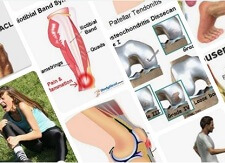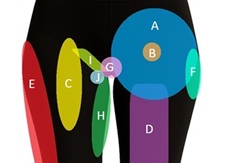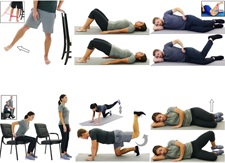- Home
- Hip Pain Diagnosis
- Hip Stretches
Hip Stretching Exercises -
The Best Stretches to Loosen Tight Hips
Written By: Chloe Wilson, BSc(Hons) Physiotherapy
Reviewed by: KPE Medical Review Board
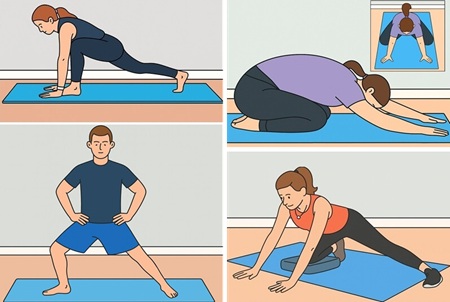
Hip stretching exercises are movements that lengthen the muscles around the hip joint to improve flexibility, mobility and comfort.
They target tight areas such as the hip flexors, inner thighs and outer hips, helping reduce stiffness and hip pain.
Hip stretches are one of the most effective ways to loosen tight hips, improve flexibility and ease discomfort. If your hips often feel stiff or achy, you’re not alone — most of us spend hours each day sitting, which leaves our hip muscles shortened and tense. Over time, this can reduce mobility, affect posture, and even cause pain in the hips, back or knees.
Here we will look at some of the best hip stretching exercises to help release tightness, restore movement, and ease pain and discomfort. Whether you’re dealing with hip pain, recovering from an injury, or just looking to move better, these hip stretches will help your hips feel looser, stronger and more comfortable.
The Best Hip Stretching Exercises
Hip stretching exercises look to target all of the key muscle groups around the hip:
- Hip Flexor Stretches: for the muscles at the front of the hip and thigh
- Inner Hip Stretches: for the inner hip, thigh and groin muscles
- Outer Hip Stretches: for the outer hip and buttock muscles
Let’s look at the most effective hip joint pain stretching exercises for each area of the hip. You don’t need to do all of these hip stretching exercises – pick your favourite pair from each section
How To Stretch Hip Flexors
Hip flexor stretches target the muscles at the front of the hip, including iliopsoas and rectus femoris, which are responsible for lifting your thigh toward your chest. These muscles become tight easily — especially if you sit for long periods or do activities involving repetitive hip flexion, like cycling or running.
When the hip flexors are shortened, they can tilt your pelvis forward, reduce hip extension and contribute to lower back or hip flexor pain.
1. Chair Hip Flexor Stretch

- While standing, place the knee of the leg to be stretched on
a chair as shown
- Step your standing leg forwards, lean forwards and bend the
knee until you feel a stretch in the front of the thigh
- Hold for 30 seconds and repeat 3 times
Top Tip: Place a cushion or pillow underneath your knee for comfort
To Increase The Stretch: start with the standing leg further forwards (further away from the chair)
Alternative: if you prefer not to use a chair, simply do this exercise kneeling on the ground, rocking forwards onto your front bent knee. This is a classic hip flexor stretch but tends to be less comfortable on your knee than doing it on the chair
2. Lying Hip Flexor Stretch
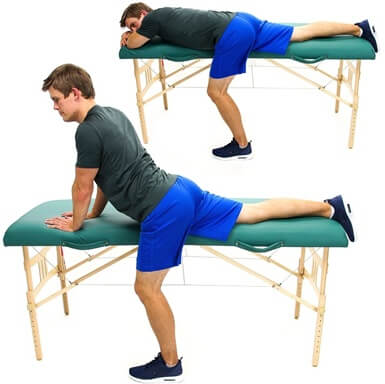
- Lie on a bed/table with one leg hanging off the side and the
leg to be stretched lying flat on the bed
- Lift yourself up on your elbows/hands until you feel a
stretch in the front of the hip/thigh
- Hold for 30 seconds and repeat 3 times
To Increase The Stretch: Bring your hands closer to your body so you are propped up higher
3. Plank Lunge
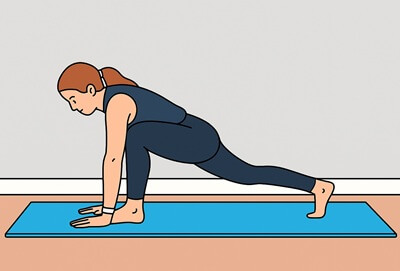
- Start in a high plank position with your hands directly
under your shoulders
- Step one foot forwards between your hands
- Let your pelvis drop, until you feel a stretch in the front of
your hips
- Hold this hip flexor stretch for 30 seconds and repeat 3 times
Hip flexor stretches like these help counteract the effects of sitting and can ease hip and lower back discomfort.
How To Stretch Inner Hip
Inner hip stretches focus on the adductor muscles — the muscles on the inside of the thigh that pull the legs together and stabilize the pelvis. Tight inner hips often develop from prolonged sitting, weakness in surrounding muscles, or repetitive movements such as squatting or horseback riding.
When the inner hip muscles are tight, they can cause stiffness and groin and inner thigh pain, limit hip abduction (the ability to move your leg outward), and affect pelvic alignment which can place strain on the knees and lower back.
1. Butterfly Stretch Lying
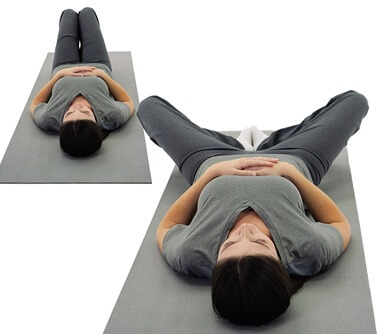
- Lie on your back on the floor with your knees bent
- Place the bottom of your feet together
- Slowly lower your knees out to the side to stretch your
inner thighs
- Hold this inner hip stretch for 30 seconds and repeat 3 times
2. Butterfly Stretch Sitting

This is similar to the last exercise but tends to give a stronger inner hip stretch
- Sit on the floor with your knees bent and feet together
- With the soles of the feet touching, slowly lower the knees outwards until you feel a stretch in the inner thighs
- Hold for 30 seconds and repeat 3 times
To Increase The Hip Stretch: Rest your elbows on your thighs and gently press down
3. Inner Hip Stretch Standing
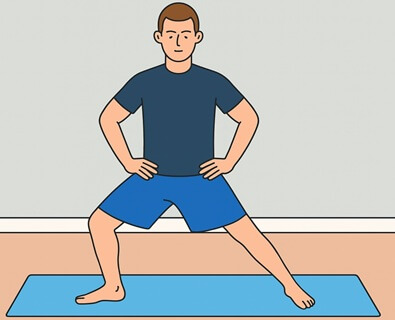
- While standing, step your feet wide apart
- Slowly take your weight over to one side, letting that knee
bend until you feel a stretch in the opposite leg
- Keep the knee straight on the target leg throughout to
ensure a strong stretch of the inner thigh
- Hold for 30 seconds and repeat 3 times
4. Hip Adductor Rock Back
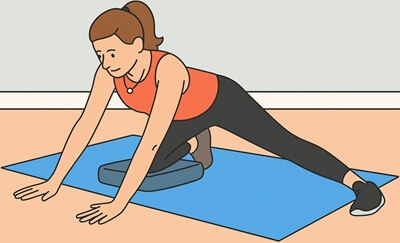
- Start by kneeling on all fours with a cushion under the target knee
- Take the leg to be stretched out to the side until you feel
a stretch in your inner thigh
- Slowly sit back onto the foot on the bent knee leg, feeling the inner hip stretch increase
To Increase The Stretch: let your foot slide further out to the side so your leg is closer to the floor
5. Frog Pose Adductor Stretch

- Start kneeling on all fours
- Widen your knees out as far as you comfortably can with your big toes touching
- Rock backwards taking your buttocks towards your heels
- Rest down on your forearms and let your chest and head drop towards the floor until you feel a stretch in the inner thighs and groin
These stretches for inner hip pain can relieve tightness from overuse, running, or muscle imbalance.
How To Do Outer Hip Stretches
Lateral hip stretches target the muscles along the outside and back of the hip, including the glutes, iliotibial band (ITB), piriformis, and deep hip rotators. These muscles help stabilize the pelvis, control rotation, and support walking, running, and single-leg movements.
These muscles often tighten due to sedentary behaviour, prolonged sitting or repetitive overuse, which can contribute to lateral or outer hip pain and deep glute discomfort. Outer hip stretches help improve rotation, release tension, restore pelvic alignment, enhance stability, and reduce pressure on nearby joints like the lower back or knees.
1. Seated Faber Stretch
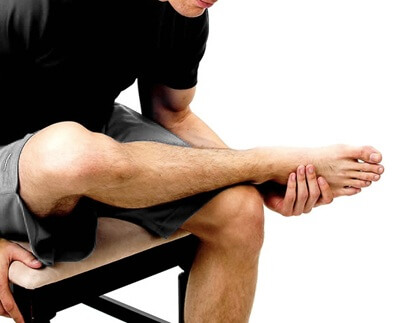
- Sit in a firm chair and cross the leg to be stretch over the
top of the other leg, so your ankle is resting on your knee as shown
- Gently lean forwards until you feel a strong stretch in the hip/buttocks
- Hold for 30 seconds and repeat 3 times
To Increase The Stretch: Gently press down on the crossed
knee as you do the exercise
: Lean over to the opposite side, taking your chest over
the stationary hip
2. Reverse Faber Stretch
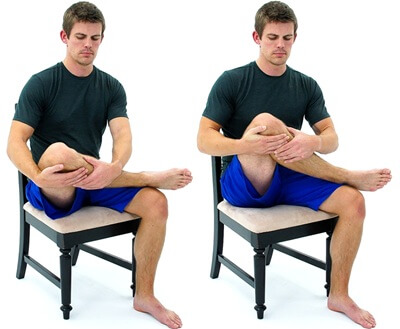
- Sit in a firm chair and cross the leg to be stretch over the top of the other leg, so your ankle is resting on your knee as shown (same starting position as Seated Faber)
- Gently draw your top knee up towards your midline until you feel a stretch in your buttock
- Hold for 30 seconds and repeat 3 times
3. Pretzel Stretch

- Lie on your back with both knees bent
- Cross one leg over so
that the foot rests on your opposite knee, making a figure 4 shape
- Bring both knees towards your chest until you feel a stretch in the buttocks on the twisted hip
To Increase The Stretch: Hold the back of the thigh and pull the leg towards you as shown in the picture
These stretches for lateral hip pain are simple yet effective ways to release outer hip tension and improve movement through the hips and pelvis.
Why Are Hip Stretching Exercises Important
Hip stretches are really important for keeping our hips healthy. The hips are one of the most mobile joints in the body, supporting everything from walking to squatting to standing upright. But they are also prone to stiffness, especially if you sit a lot or lead an active lifestyle without regular mobility work.
Tight hip muscles can contribute to hip pain, back pain, knee pain and even reduced athletic performance. Regular stretching exercises for hip pain help to:
- Improve hip range of motion and flexibility
- Reduce muscle tension and joint stiffness
- Relieve hip joint pain and muscle tightness
- Prevent injuries and improve posture
- Keep you moving comfortably and freely
Tight hip muscles commonly lead to issues such as:
- Hip Tendonitis
- Hip Bursitis
- Hip Impingement
- Hip Strains
- Hip Pain At Night
- Iliotibial Band Syndrome (ITBS)
Regularly doing hip pain stretches alongside hip strengthening exercises can reduce the risk of developing hip problems.
How to Stretch
Effectively
Knowing how to do hip stretching exercises properly is essential for getting the best results. Technique and timing make all the difference when it comes to improving flexibility, reducing stiffness and preventing injury with hip stretches.
So here are our top tips on how to stretch hip muscles effectively:
- Move Into The Stretch
Slowly: Ease into each movement until you feel mild to moderate tension — never
pain. Avoid bouncing or forcing the movement as this can strain the muscles
- Hold Each Stretch: For
maximum benefit, hold each hip muscle stretch for 30 seconds, or up to 60
seconds if your hips are particularly tight. This allows time for the muscle
fibres to relax and lengthen
- Repeat: Perform 3
repetitions per side for each hip pain stretch
- Stretch Regularly: Aim
for 3–5 times a week (daily if you have ongoing hip stiffness or pain)
- Breathe Deeply: Slow, steady breathing helps relax the muscles and deepen each stretch. Exhale as you relax into the movement — this helps your body release tension and increases the stretch’s effectiveness.
Consistency and patience are key with hip muscle stretches - your hips will loosen gradually over time.
FAQs on Hip Stretches
Why Are Hip Stretching Exercises Important?
Why Are Hip Stretching Exercises Important?
Hip muscle stretches help:
- Reduce stiffness and muscle tension
- Improve range of motion and movement efficiency
- Prevent lower back, knee, and hip pain
- Counteract the effects of prolonged sitting
- Enhance athletic performance and daily functional movements
Regular hip stretching exercises support healthy hips, improve posture, and reduce the risk of injury.
How Do I Know If I Have Tight Hip Muscles?
How Do I Know If I Have Tight Hip Muscles?
You may have tight hips if you experience stiffness when standing up after sitting, discomfort when crossing your legs, or pain in the front, sides, or back of your hips. Tight hip flexors can cause an anterior pelvic tilt, while tight glutes or adductors can limit your hip range of motion.
Try a simple test: lie on your back with one leg pulled toward your chest and the other flat on the ground. If the extended leg lifts off the ground or the hip flexes upward, your hip flexors are likely tight.
What Causes Tight Hip Muscles?
What Causes Tight Hip Muscles?
Tight hip muscles are often caused by prolonged sitting, which keeps the hip flexors in a shortened position for hours and they gradually tighten and shorten.
Other common causes include overuse from running or cycling, muscle imbalances, poor posture, stress, and a lack of stretching. Over time, these habits reduce flexibility, limit hip range of motion, and may lead to hip or lower back pain.
What Causes One Hip To Be Tighter Than The Other?
What Causes One Hip To Be Tighter Than The Other?
It’s very common for one hip to feel tighter than the other due to leg dominance, posture habits, or previous injuries. For example, standing or shifting weight predominantly on one leg, sitting with legs crossed in one direction, or favouring one side during exercise can create muscle imbalances. Regular hip stretching exercises on both sides help restore symmetry and balance.
Should I Stretch Before Or After Exercise?
Should I Stretch Before Or After Exercise?
Both are beneficial, but the type of stretch matters:
- Before exercise: Use dynamic hip stretches, which involve controlled movement to warm up the muscles and prepare the hips for activity. Examples include leg swings or walking lunges.
- After exercise: Switch to static hip stretches, holding positions for 30–60 seconds, to improve flexibility, relax the muscles and help them recover, and reduce post-workout tightness.
Is It Normal For Hip Stretches To Hurt?
Is It Normal For Hip Stretches To Hurt?
You should feel a gentle pulling or mild discomfort when stretching tight hip muscles, but you should never feel sharp pain. If a stretch causes pain deep in the joint or radiating discomfort, stop immediately — this may indicate irritation, inflammation, or an underlying condition such as bursitis or impingement.
To stay safe, ease into stretches slowly, avoid forcing the movement, and only stretch to the point of gentle tension, not pain. Overstretching can actually make tight muscles tighten further as a protective reflex.
Can Hip Stretching Relieve Hip Pain?
Can Hip Stretching Relieve Hip Pain?
Yes, gentle hip pain stretches can help relieve stiffness and improve movement in people with conditions such as hip arthritis, tendonitis or bursitis. Stretching keeps the joint lubricated, reduces muscle tension around the hip, and can ease pressure on inflamed tissues.
However, avoid pushing into pain when doing hip stretching exercises— use slow, gentle movements and consult a healthcare professional if symptoms persist or worsen.
Can Hip Stretching Exercises Reduce Lower Back Pain?
Can Hip Stretching Exercises Reduce Lower Back Pain?
Absolutely. Tight hip flexors and glutes can pull on the pelvis and spine, leading to poor posture and lower back pain. Regular hip muscle stretches help restore balance between the front and back of the hips, reducing strain on the lumbar spine and improving overall posture.
What Is The Difference Between Hip Mobility And Hip
Flexibility?
What Is The Difference Between Hip Mobility And Hip Flexibility?
Hip flexibility refers to how much your muscles can lengthen. For example, tight hip flexors or glutes limit your range of motion.
Hip mobility refers to how freely your hip joint itself can move through different directions and is often limited in conditions such as hip arthritis.
Both are important: flexibility allows your muscles to stretch safely, while mobility ensures full, smooth joint movement. Hip stretching exercises improve flexibility, but strengthening exercises are needed to improve joint mobility.
Hip Stretches Summary
Regular hip stretching exercises are one of the best ways to ease stiffness, improve flexibility and reduce hip pain. Tight hip flexors, inner thighs and outer hip muscles are common from sitting too long, poor posture or overuse, which can limit movement and cause discomfort in the hips, back and knees. Hip muscle tightness is often linked to hip conditions such as hip bursitis, hip tendonitis and muscle strains.
The best hip stretching exercises help lengthen tight muscles, improve hip mobility and restore balance around the joint. Whether you are doing hip flexor stretches, inner hip stretches or outer hip pain stretches, focus on moving slowly, holding each stretch for 30 seconds, and breathing deeply. Hip joint pain stretching exercises work most effectively when combined with hip strengthening exercises.
With regular practice, hip pain stretches can make your hips feel looser, stronger and more comfortable. Consistency is key — a few minutes a day of gentle hip muscle stretches can make a big difference to how you move and feel, helping keep your hips flexible, balanced and pain-free.
You may also be interested in the following articles:
- Front Hip Pain
- Inner Hip Pain
- Outer Hip Pain
- Upper Thigh Pain
- Hip Pain At Night
- Knee Pain Diagnosis Charts
Related Articles
Knee Pain Diagnosis
March 27, 2025
Hip Pain Diagnosis
September 16, 2025
Hip Strengthening
September 24, 2025
Medical & Scientific References
- The Influence of Stretching the Hip Flexor Muscles on
Performance Parameters. A Systematic Review with Meta-Analysis. International
Journal of Environmental Research & Public Health
- Improved Hip Flexibility and Gluteal Function Following a
Daily Lunge-and-Reach Stretching Intervention. International Journal Of Sports
Physical Therapy
- The Effect Of Static Stretching Exercises On Hip Range Of
Motion, Pain, And Disability In Patients With Non-Specific Low Back Pain. Journal
Of Experimental Orthopaedics
- Stretches For The Hip. Cambridge University Hospitals NHS Foundation Trust
Last Updated: November 4th, 2025
Next Review Due: November 4th, 2027
